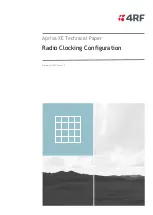
72
58-603 Pulsar
®
Model R86 Radar Transmitter
4.x Echo Margin
Echo Margin is a unique parameter that, when used along with Echo Strength can be a very useful
troubleshooting tool. Echo Strength is taken from the standard Signal-to-Noise calculation and is
simply defined as:
“The amplitude of the Level echo in Echo Strength units (0-100)”
Echo Margin is defined as:
“A numeric value that is related to the strength of the target peak relative to the Level Threshold or
competing waveform features, i.e. "noise.”
The Echo Margin value (for the typical First Echo mode) is calculated as the difference of the False
target-to-Threshold OR the Level target-to-Threshold whichever is SMALLER.
By reporting the SMALLER value, Echo Margin does a better job of reporting which issue is most
likely to become a problem:
• False Target- if this echo becomes large enough to rise above the Threshold it will be mistakenly
reported as the Level.
• Level Echo- if this echo becomes small enough to fall below the Threshold the transmitter will report
Loss of Echo.
Always examine both Echo Strength and Echo Margin values. Increasing a Gain parameter
(Dielectric, Turbulence, Foam or Sensitivity) will increase the amplitude of all echoes in the radar
scene. If, after increasing a Gain parameter, the Echo Strength increases but the Echo Margin decreas-
es a False Target is reaching closer to the Threshold (see drawing above). If the False Target reaches
above the Threshold it will be detected as a valid Level echo and will be incorrectly reported as Level.
In this case running Echo Rejection will eliminate the False Target and increase the Echo Margin
value. Echo Margin values >20 are a good goal.
4.x Automated Echo Capture
Unattended Echo Capture
One of the ways the Model R86 simplifies an often complex technology like Radar, is to improve the
speed at which a user can turn around a problem and get the device back online. Minimizing down
time is the ultimate goal of any device.
One of the most important tools used to troubleshoot a Radar application or optimize a transmitter
configuration is the echo curve. This graphical representation of a Radar echo speaks volumes to those
trained to interpret them. It is like a snapshot in time of the health of the transmitter. It is actually like
seeing inside of the tank. However, the challenge with echo curves is acquiring them in a timely fash-
ion. Unfortunately, most problems develop when there is a skeleton crew and no one watching this
particulate vessel. By the time an instrument technician can investigate, the alarm has cleared and no
one understands why it occurred or, more importantly, when it will happen again. Since an echo curve
is so important in troubleshooting the device, it is critical to capture the curve at the instant a problem









































